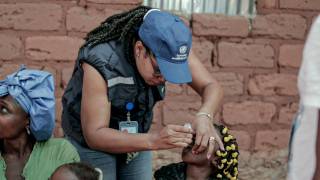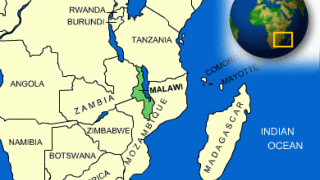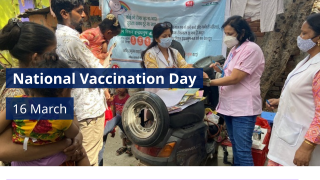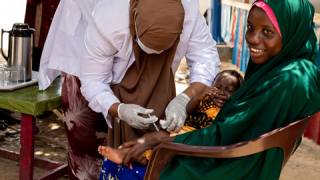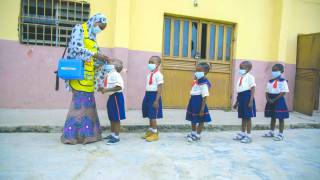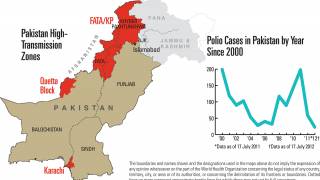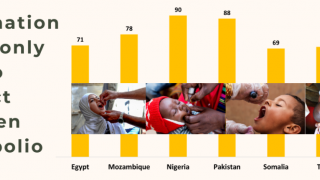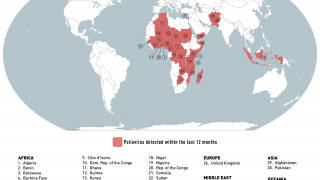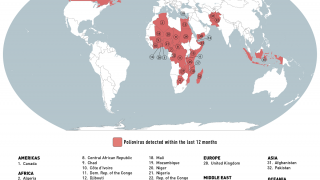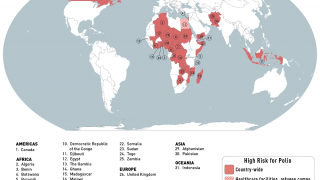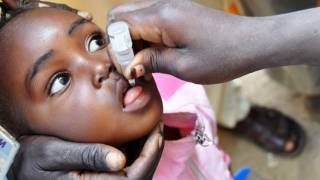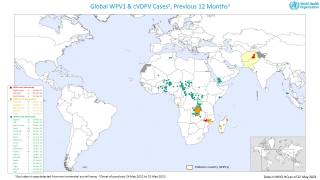19 Additional Polio Cases Reported

There were a large number of new polio cases reported during mid-July 2019. Several countries confirmed 19 new polio cases last week, according to the Global Polio Eradication Initiative's (GPEI's) weekly report.
These new polio cases were reported across the Middle East, Africa, and Asia, as of July 17, 2019.
Some of these polio issues can be traced to a 2016 vaccine decision, says the US Centers for Disease Control and Prevention (CDC).
After the 2016 switch from trivalent oral poliovirus vaccine (OPV) (types 1, 2, and 3) to bivalent OPV (types 1 and 3), the transmission of type 2 circulating vaccine-derived polioviruses (cVDPVs) was detected in countries with populations of children who had missed the vaccination to type 2 poliovirus, prior to the 2016 switch.
This week’s GPEI report confirmed:
Afghanistan: One wild poliovirus type 1 (WPV1) case has been reported in the past week in Musaqalah district, Hilmand province. The onset of paralysis was on 5 June 2019. There are 11 WPV1 cases reported in 2019 from Afghanistan. The total number of WPV1 cases for 2018 remains 21. One WPV1-positive environmental sample was reported in the past week from Kandahar district, Kandahar province. The sample was collected on 24 June 2019.
The Democratic Republic of the Congo: Five cases of circulating vaccine-derived poliovirus type 2 (cVDPV2) have been reported this week. There are 11 reported cases of cVDPV2 in 2019. The total number of cVDPV2 cases reported in 2018 is 20.
Nigeria: Three cases of circulating vaccine-derived poliovirus type 2 have been reported in the past week: one each from Wurno LGA, Sokoto State, Irewole LGA, Osun State and Baruten LGA, Kwara State. The onset of paralysis was on 20 May, 9 June and 14 June 2019 respectively. There are 12 cVDPV2 cases reported in 2019 so far. The total number of cVDPV2 cases in 2018 remains 34. Two positive environmental samples were reported in the past week: Sokoto North LGA, Sokoto State and Ilorin West LGA, Kwara State. The samples were collected on 10 and 13 June 2019 respectively. One cVDPV2 was isolated from a healthy child from Wurno LGA, Sokoto State. The sample was collected on 20 June 2019. The recent confirmation of spread of one of the cVDPV2 outbreaks, both within Nigeria and internationally, underscores the urgent need to fill remaining vaccination gaps in the ongoing outbreak response and to optimize the geographic extent and operational quality of mOPV2 response.
Pakistan: Four wild poliovirus type 1 (WPV1) cases have been reported in the past week: One each from Jehlum and Lahore districts, Punjab province, with onset of paralysis on 21 and 22 June 2019; one each from Bannu and Lakkimarwat districts, Khyber Pakhtunkhwa province, with onset of paralysis on 22 June and 01 July 2019. The total number of WPV1 cases is 45. Three WPV1-positive environmental samples were reported in the past week: one each from Quetta district in Balochistan province; Karachi district in Sindh province; Bannu district in Khyber Pakhtunkhwa province. The samples were collected between 20-27 June 2019.
Polio, or poliomyelitis, is a crippling and potentially deadly infectious disease. Polio spreads from person to person invading the brain and spinal cord and causing paralysis, says the Centers for Disease Control and Prevention (CDC).
It is caused by the poliovirus, for which there is no cure today.
Polio has been eliminated from the USA thanks to widespread polio vaccinations. Since 1979, no new cases of polio have originated in the United States, says the CDC.
The polio vaccine protects children by preparing their bodies to fight the poliovirus. Almost all children who get all the recommended doses of vaccine will be protected from polio.
There are two types of vaccine that can prevent polio: inactivated poliovirus vaccine (IPV) and oral poliovirus vaccine (OPV).
Only the IPV has been used in the United States since 2000; OPV is still used throughout much of the world.
The IPV is given by a shot in the arm or leg, depending on the person’s age. The CDC recommends that children get 4 doses of polio vaccine.
Polio news
- Polio Cases Surging in July 2019
- Polio Vaccinations Receive $100 Million Dollar Boost
- Wild Poliovirus Eradication Can Be Achieved
- Hajj Vaccination Requirements Updated for 2019
For additional information on countries with polio circulation and vaccine recommendations, consult the travel notices on the CDC Travelers’ Health website.
"Vaccines are an important part of pre-trip planning because they help prevent the spread of local diseases,” said Maegan Whisenhunt, PharmD candidate, Brookshires Grocery Company.
"However, depending on where patients are traveling to, they may need to receive a booster vaccination at least 4 weeks before traveling,” continued Whisenhunt.
Pre-trip, polio vaccine counseling appointments can be scheduled with a local pharmacy at Vax-Before-Travel.
Polio vaccines, like any medicine, can have side effects. You are encouraged to report polio vaccine side effects to a healthcare provider or the CDC.
Our Trust Standards: Medical Advisory Committee






